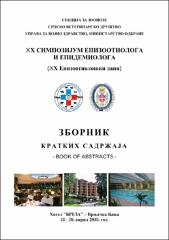| dc.contributor.author | Lupulović, Diana | |
| dc.contributor.author | Medić, Strahinja | |
| dc.contributor.author | Savić, Sara | |
| dc.contributor.author | Petrović, Tamaš | |
| dc.contributor.author | Lazić, Gospava | |
| dc.contributor.author | Samojlović, Milena | |
| dc.contributor.author | Lazić, Sava | |
| dc.date.accessioned | 2019-11-03T17:03:37Z | |
| dc.date.available | 2019-11-03T17:03:37Z | |
| dc.date.issued | 2018 | |
| dc.identifier.isbn | 978-86-83115-33-4 | |
| dc.identifier.uri | https://repo.niv.ns.ac.rs/xmlui/handle/123456789/120 | |
| dc.description.abstract | West Nile virus (WNV), Borrelia burgdorferi sensu lato (B. burgdorferi s.l.) and Equine infectious anaemia virus (EIAV) are recognized as causative agents of major emerging zoonotic infections that can affect horses and other equids. The common feature for these diseases is that they need vectors for the transmission – mosquitoes, ticks and bloodsucking horseflies.
The aim of this study was to investigate the presence of specific antibodies against WNV, B. burgdorferi s.l. and EIAV in 176 horse blood sera samples. Blood samples from the different horse breeds were collected during 2011 and 2012 from 18 municipalities in the northern part of Serbia (Vojvodina Province) and Belgrade. For the detection of IgG anti-WNV antibodies and anti- B. burgdorferi s.l were applied commercial ELISA kits, according to manufactures’ instructions. Antibodies against EIAV were identified by agar gel immunodiffusion test (AGID) - Coggins test, prescribed by OIE as a standard laboratory test.
Positive serological findings for WNV among horses in the region of study was 26.14% (46/176) and for B. burgdorferi s.l. 8.52 % (15/176). However, for WNV and B. Burgdorfer s.l., doubtful results were detected in 1.14 % (2/176) and 10.22 % (18/176) of samples, respectively. The simultaneous presence of positive results for WNV and B. burgdorferi s.l was diagnosed in 1.14 % (2/176) of specimens, while suspicious results for B. burgdorferi s.l. and positive results for WNV were detected in 2.27% (4/176) samples. All tested samples reacted negative on the presence of EIAV. There were no clinical signs of the examined diseases in tested horses.
Based on the obtained results, we can conclude that the seroprevalence of WNV in the population of horses in Vojvodina Province and Belgrade is quite high; Lyme borreliosis is less prevalent while there is the least threat from Equine infectious anaemia. At least 3.41% (6/176) horses were disposed to the contact with mosquitoes and ticks at the same time. It is important to continue monitoring of WNV, Lyme borreliosis and EIAV in horses as well as to control and eradicate the vectors that are responsible for transmission of these diseases in nature. | en_US |
| dc.description.sponsorship | This paper was realized as a part of the project TR31084, funded by the Ministry of Education, Science and Technological Development of the Republic of Serbia | en_US |
| dc.language.iso | other | en_US |
| dc.publisher | Srpsko veterinarsko društvo, Sekcija za zoonoze | en_US |
| dc.source | Zbornik kratkih sadržaja, XX Simpozijum epizootiologa i epidemiologa (XX Epizootiološki dani), Vrnjačka Banja, 18-20. april 2018 | sr |
| dc.subject | konji | en_US |
| dc.subject | vektori | en_US |
| dc.subject | zoonozne bolesti | en_US |
| dc.subject | Vojvodina | en_US |
| dc.subject | Beograd | en_US |
| dc.title | Serološko ispitivanje važnijih vektorskih zaraznih bolesti konja | en_US |
| dc.title.alternative | Serological survey of some important vector-borne diseases in horses | en_US |
| dc.title.alternative | | en_US |
| dc.type | Book chapter | en_US |

